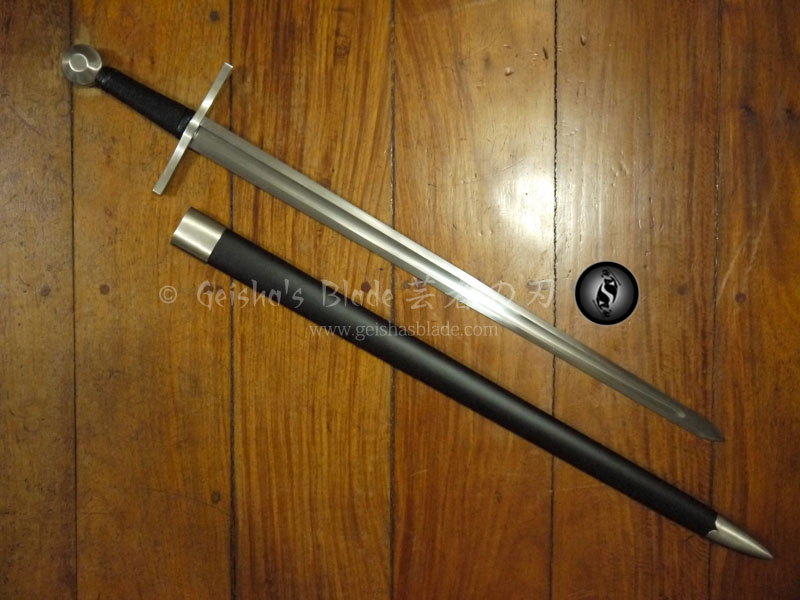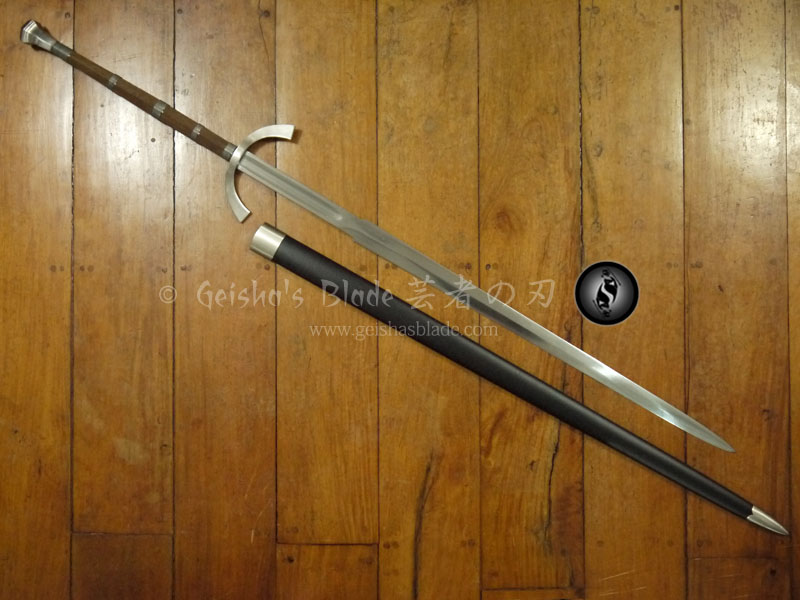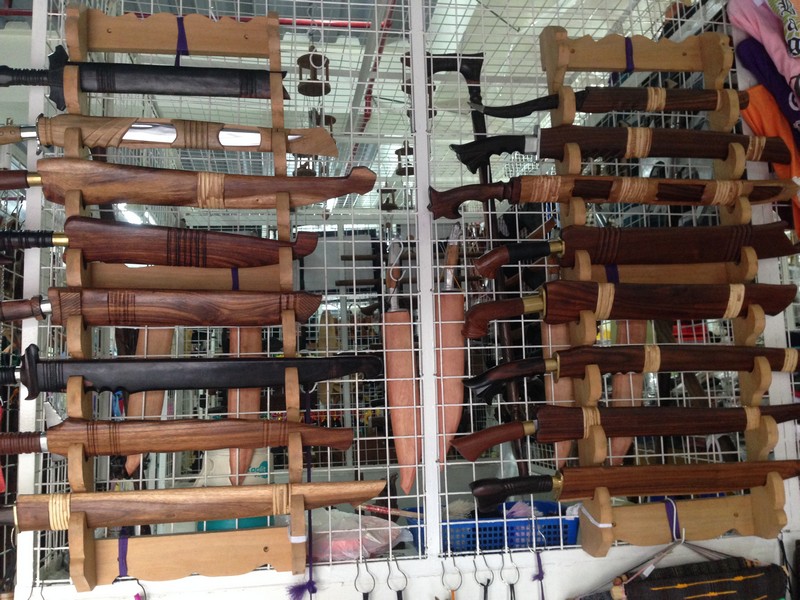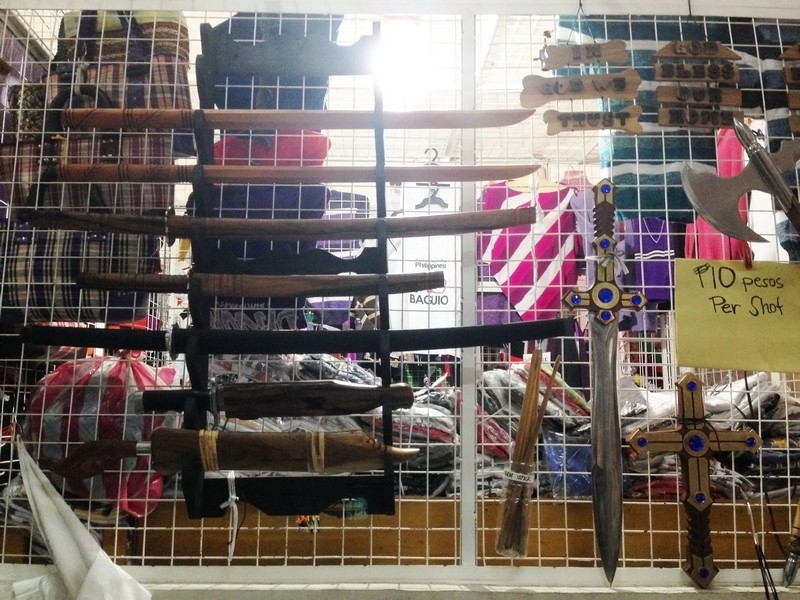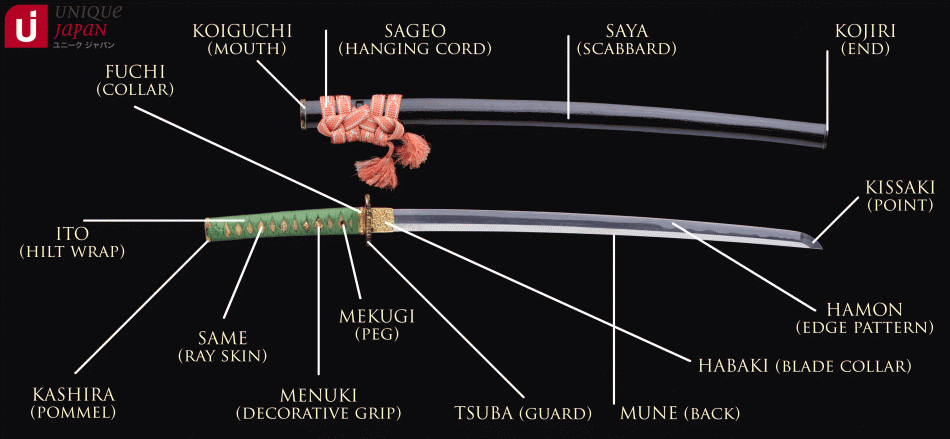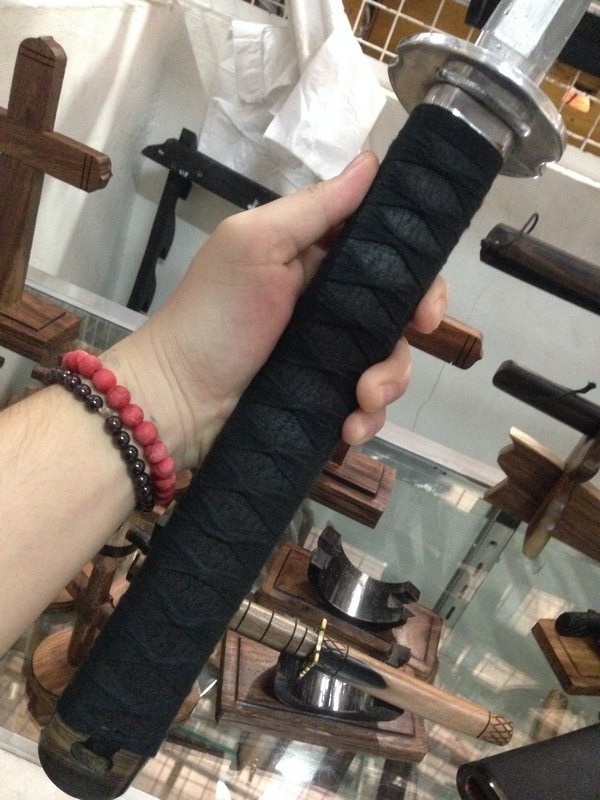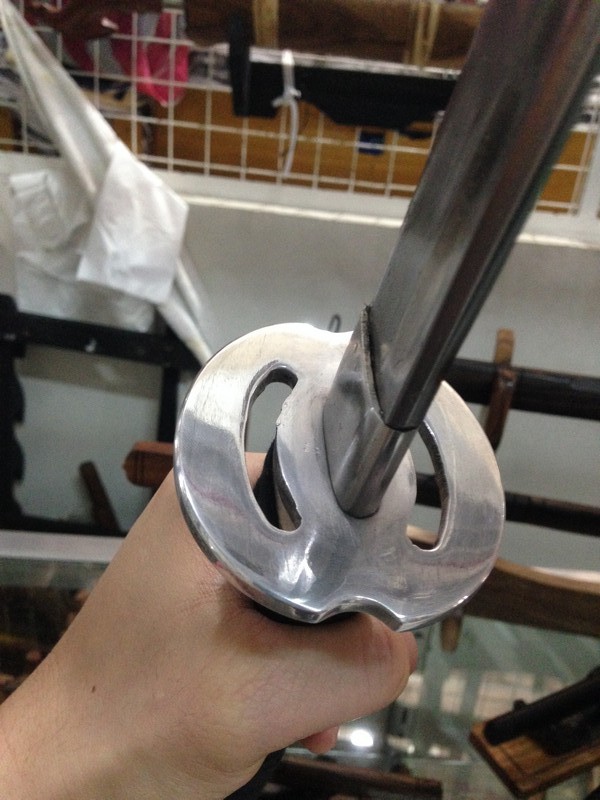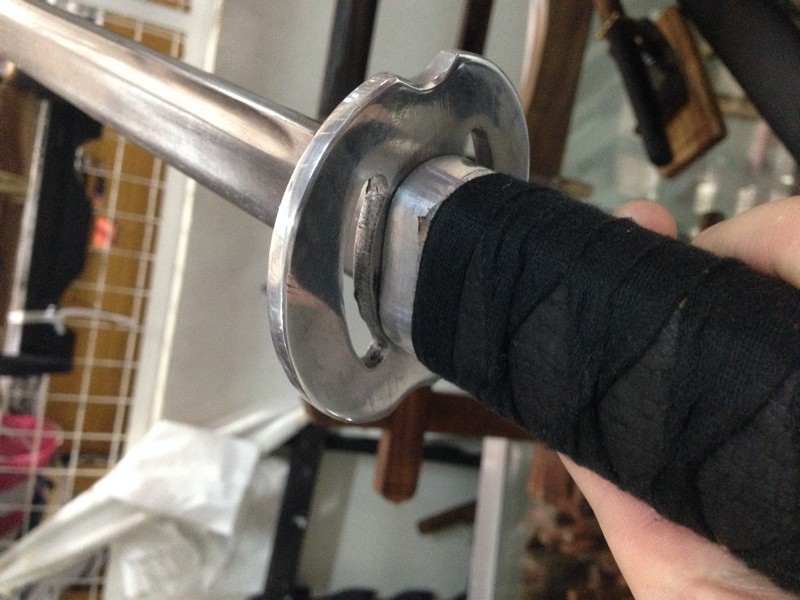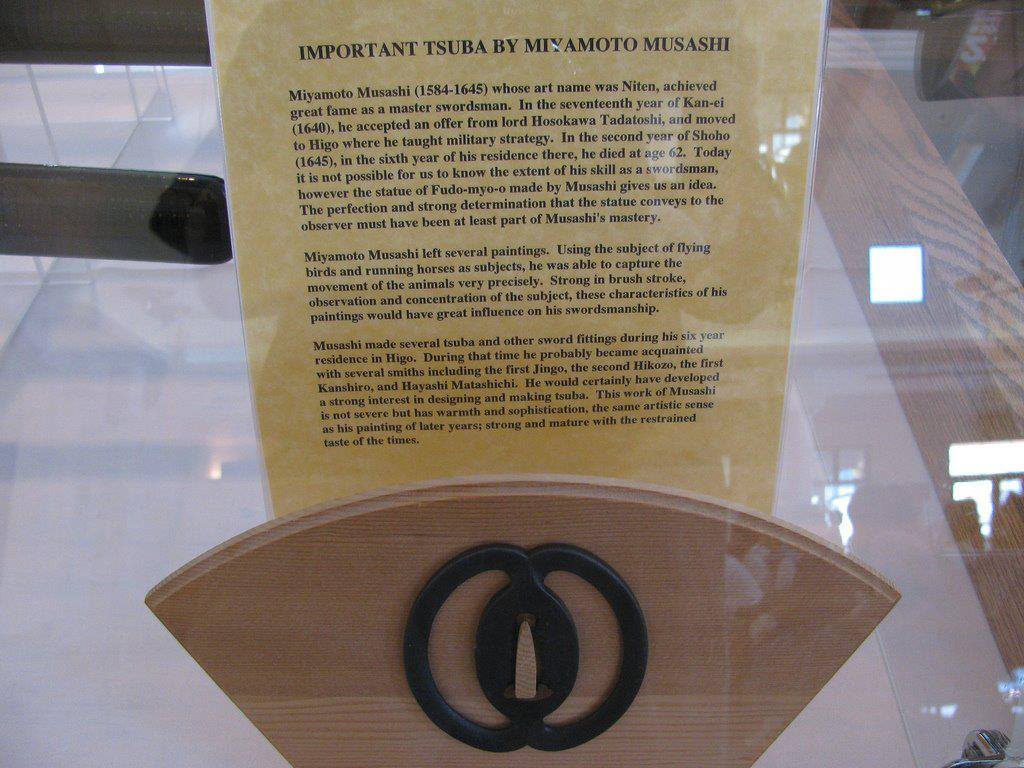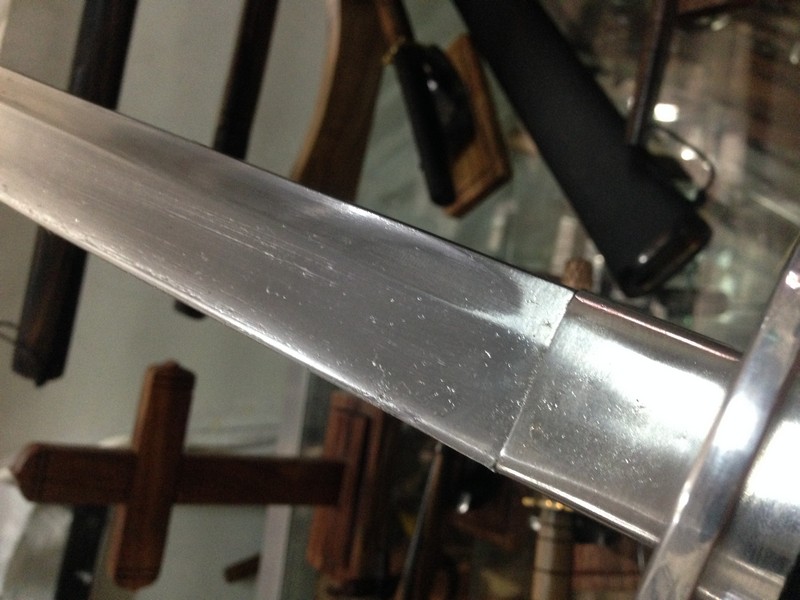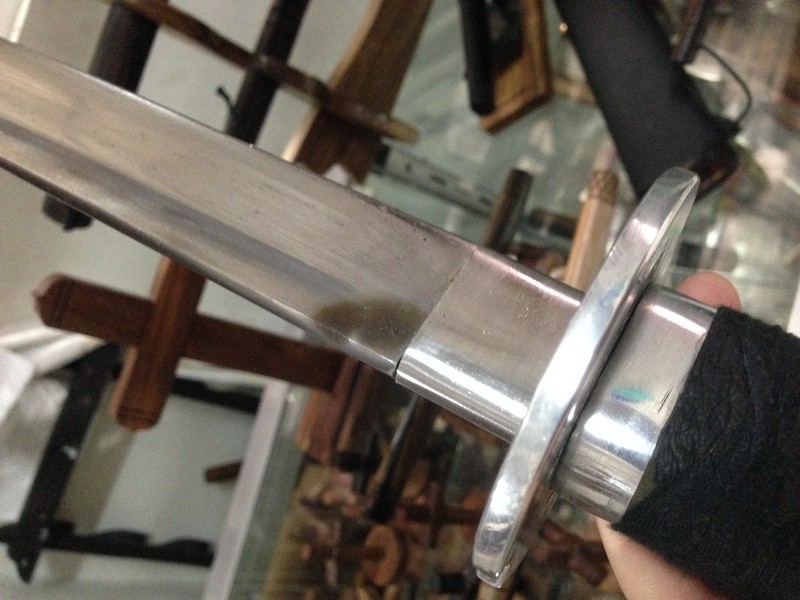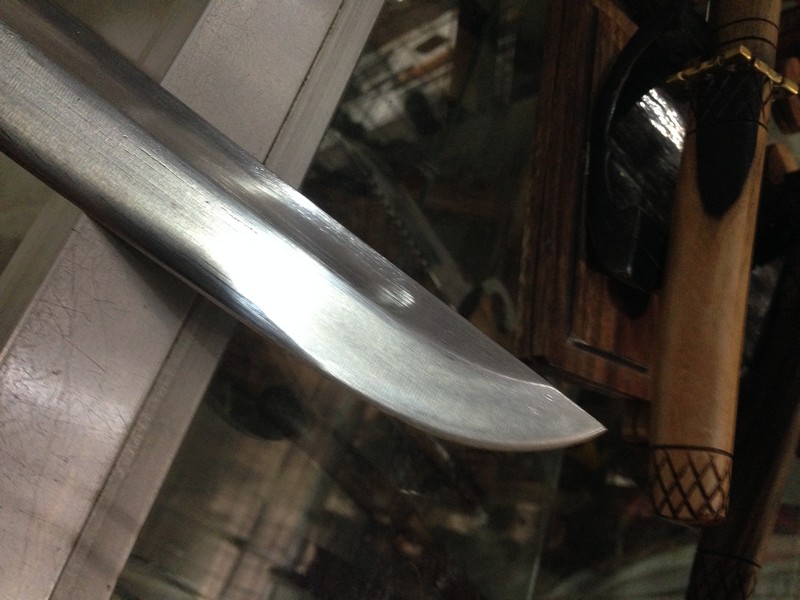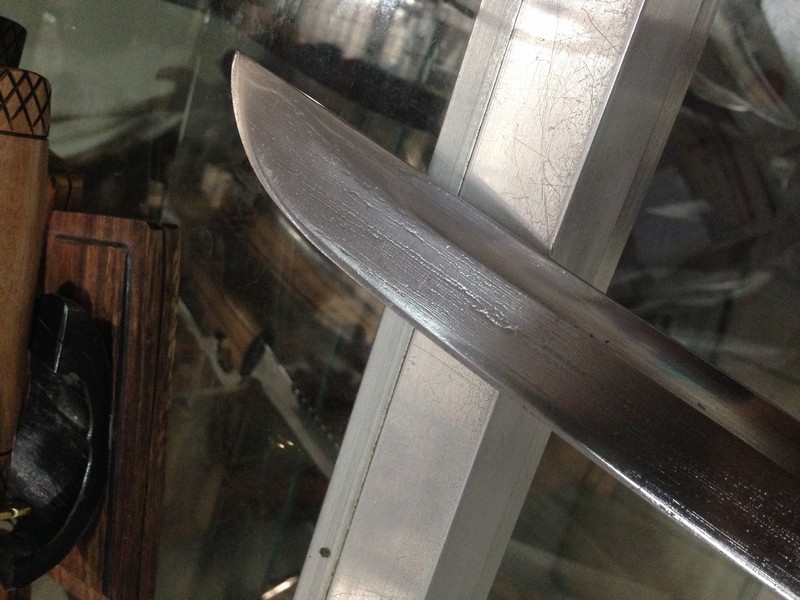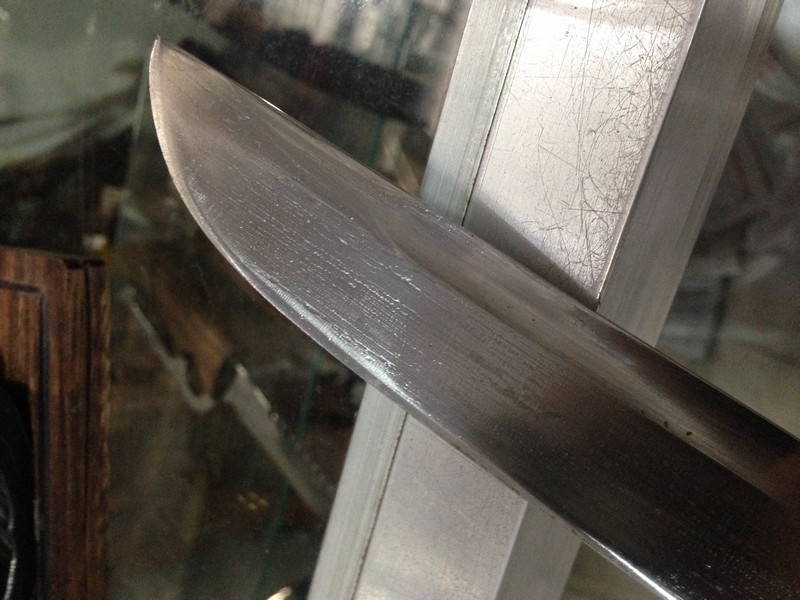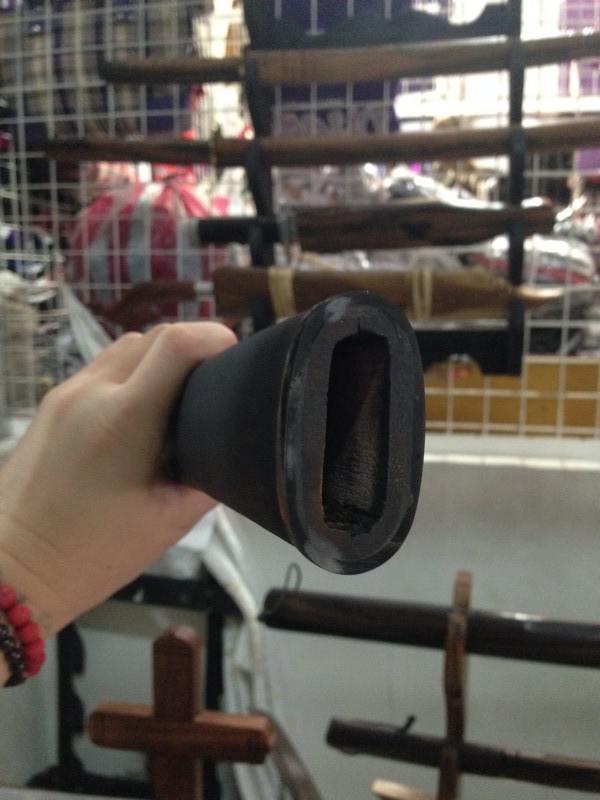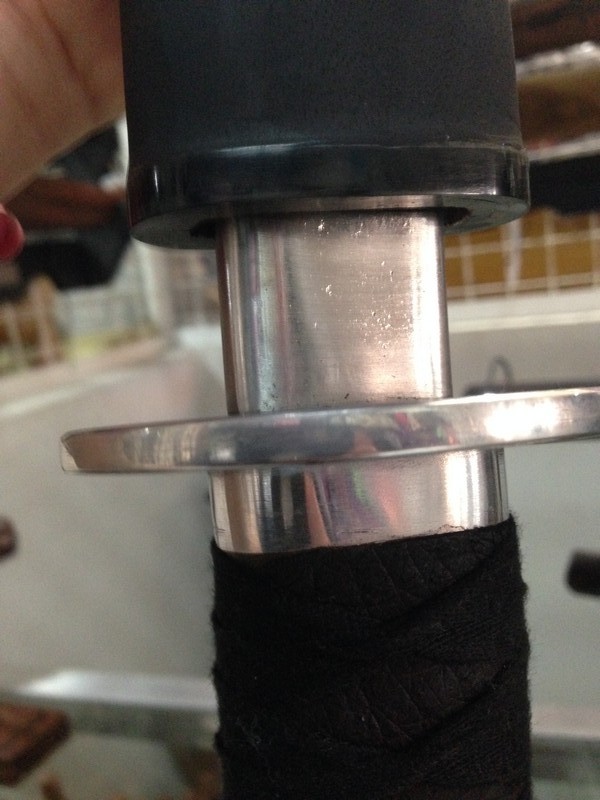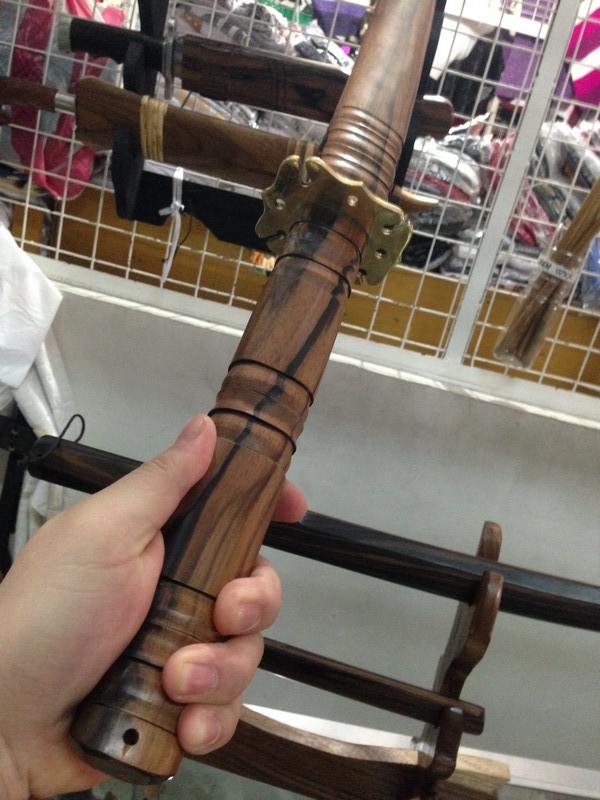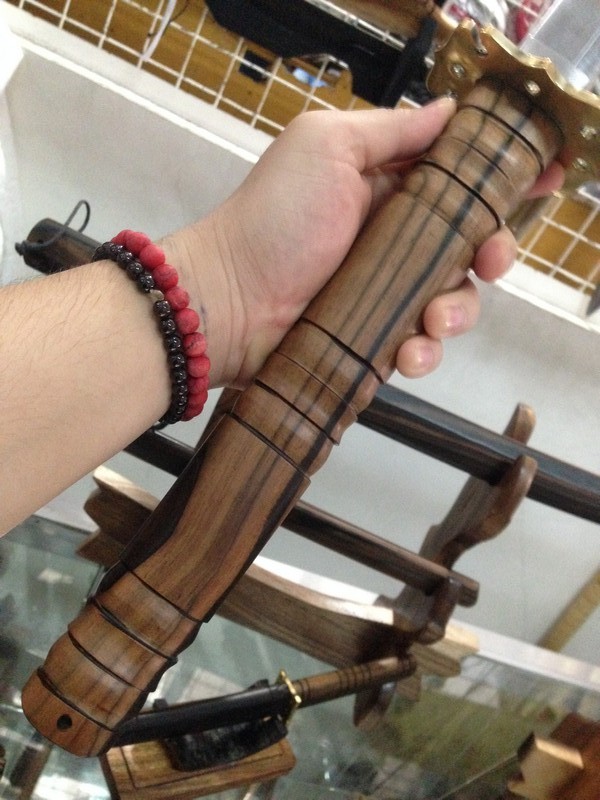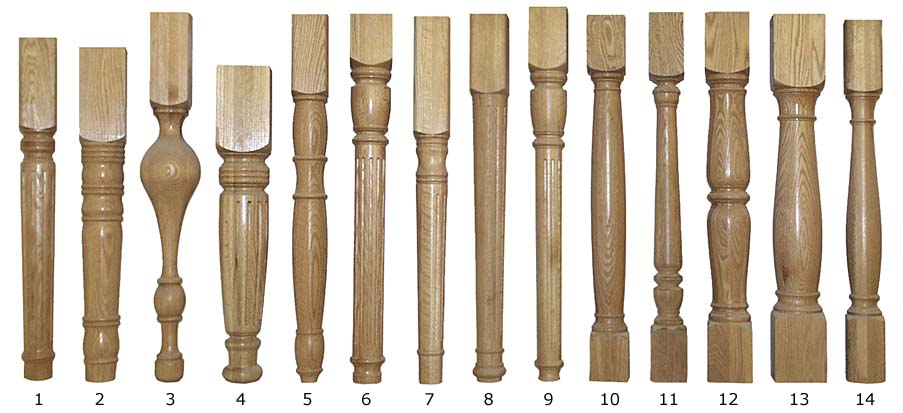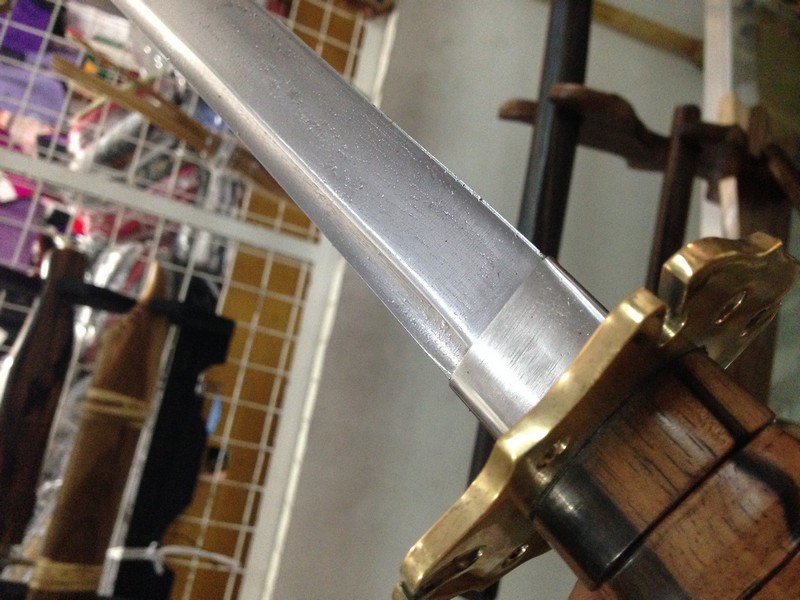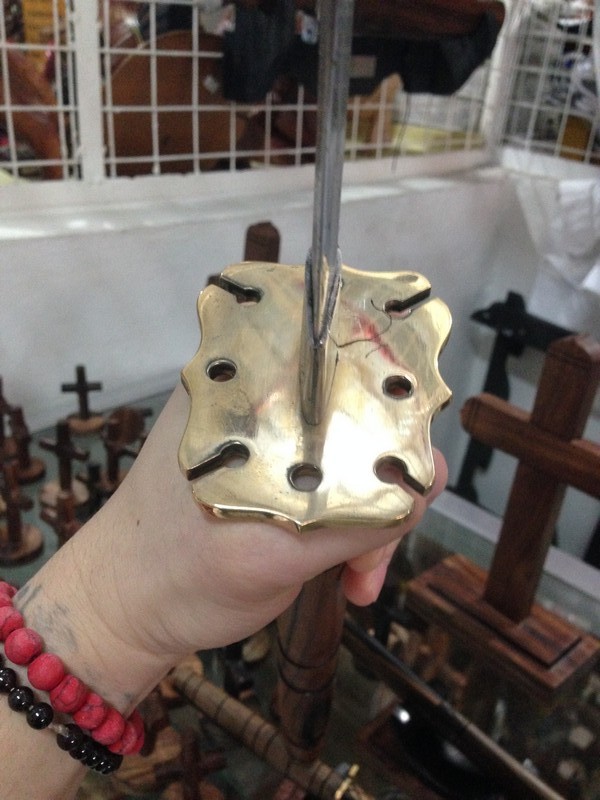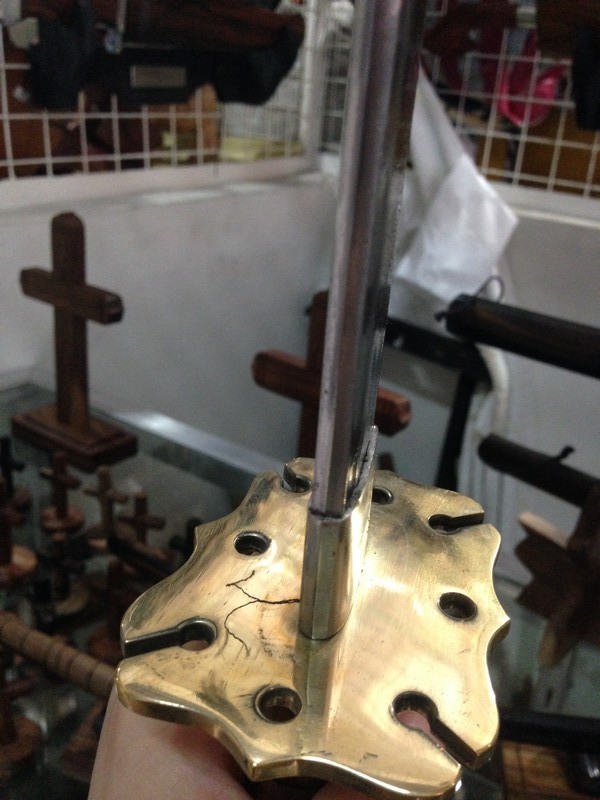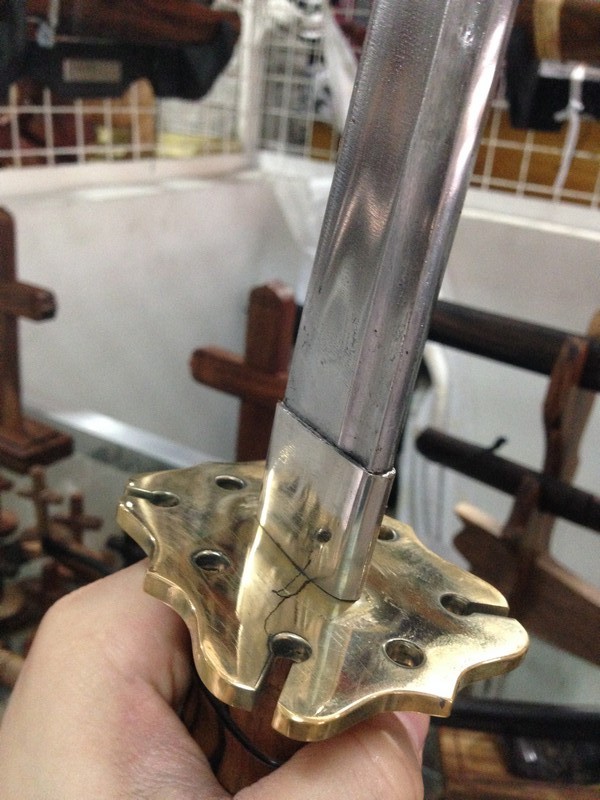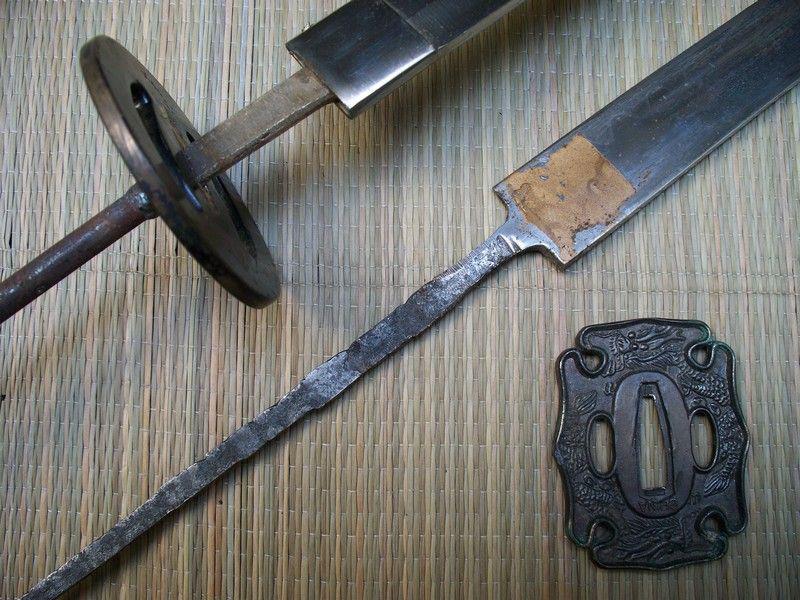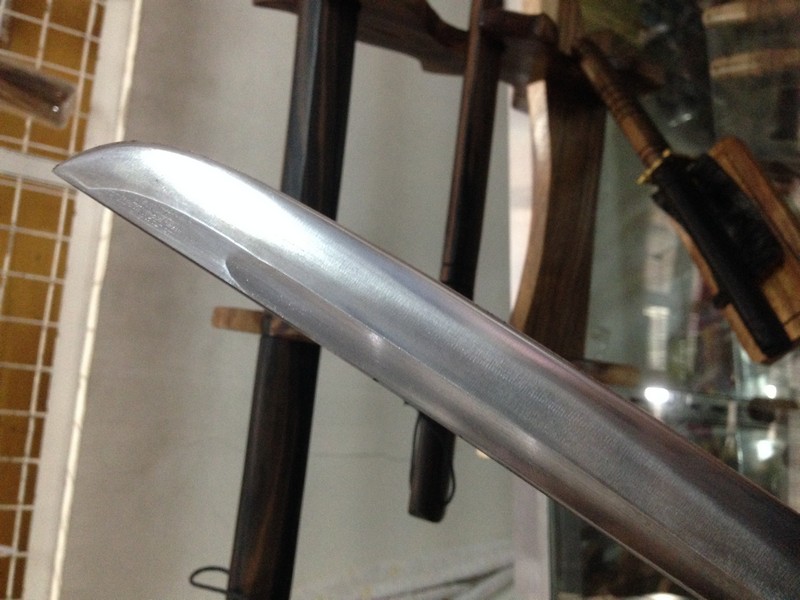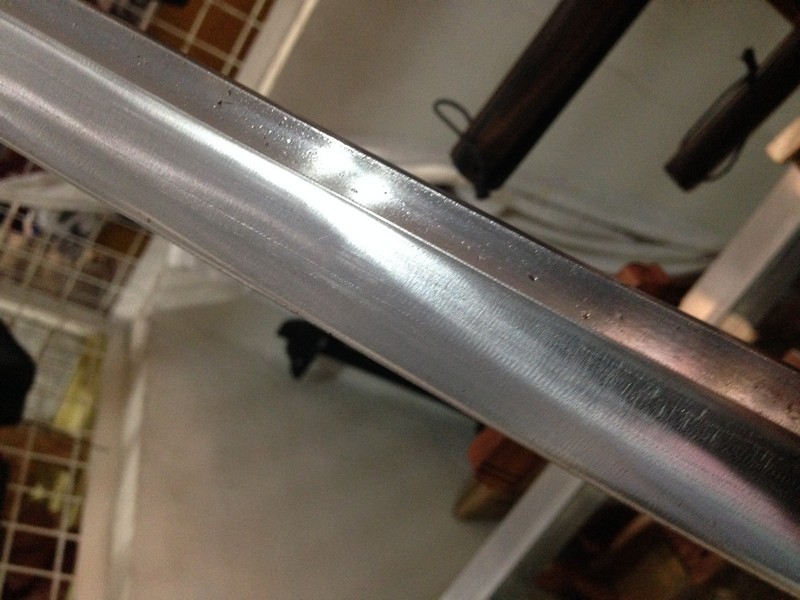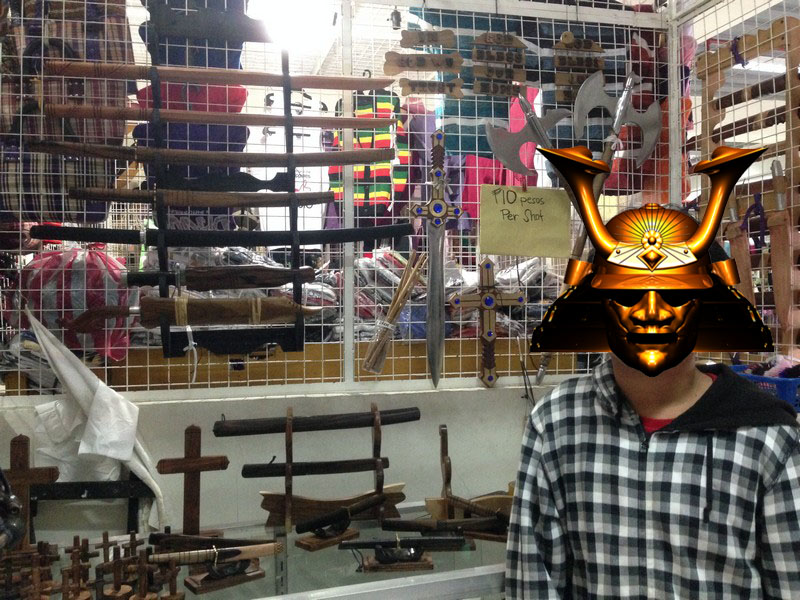A visual and hands-on review of a “samurai katana sword” made in the Philippines
By Aldwin P. (consumer, sword collector, Japanese martial arts practitioner)
Last week, we went on a road trip to Baguio City to beat the summer heat. This is where I bought my first “katana” from when I started collecting many years ago. Here’s an article I wrote comparing the cheap “samurai sword” I bought in Baguio and a cheap one made in China. Back then, I knew very little about samurai swords and didn’t know the difference between a good quality katana from a cheap one.
I learned that a company/sword maker from Pozorrubio, Pangasinan has a stall at Mines View Park. I decided to head over there and check it out. I won’t be mentioning any names, but they are ones who made the sword used in the local TV show, Juan Dela Cruz, aired on ABS-CBN.
It costs PHP 10 per shot if you want to have your photo taken with the sword.
This sword maker claims that they also made the swords used in the movies Lord of the Rings and Braveheart (as seen in this video). This is all untrue. None of the swords from those movies were made by them or anywhere in the Philippines. Weta Workshop in New Zealand made all the swords used in the above-mentioned movies. (You can watch this video about Lord of the Rings featuring Weta Workshop.)
Christopher Lee (Saruman) at 00:11
“I went to the Weta Workshop which is quite unlike anything I have ever seen in my entire career, and they made everything you see in the film. They made all the armor, all the weapons. Richard Taylor, the man in charge, I think he’s a genius!”
Skip to 33:29 for the discussion about the swords used in the movies.
If that video is not enough proof since it was uploaded just last year, here’s a discussion thread over at Sword Forum International (SFI) posted on 08-08-2002, where one of the members of SFI, Björn Hellqvist, interviewed the men behind the swords in LOTR. This interview was copyrighted 2002.
As for the William Wallace sword from the 1995 movie ‘Braveheart’, it was made in the UK by Simon Atherton, master armourer at Zorg Ltd. He also designed and crafted swords for the movie Gladiator, Troy, Kingdom of Heaven, The Three Musketeers, and many more. The most recent are the swords from Keanu Reeves’ 2013 fantasy movie: 47 Ronin. From a discussion thread on Sword Forum International in 2003 (reply #2).
“The original sword used by Mel Gibson was designed and built by Simon Atherton using a Del Tin blade. Del Tin supplied many of the other swords and other weapons (except the rubber ones, of which there were many).”
And these other resources:
Zorg Ltd (Simon Atherton’s company)
Los Angeles Times
Now that it’s all clear, let’s continue with their stall in Mines View Park. They only have a few swords on display, but you can find all of their products in their store in Pozorrubio, Pangasinan. Their stall displays several varieties of Filipino blades and a couple of “samurai” (as they call it). They have 2 designs on display. The first one is an all-black design, while the other one is all wood.
Before I start with the review, let’s take a look at the basic parts of a Japanese sword.
Photo courtesy of Unique Japan
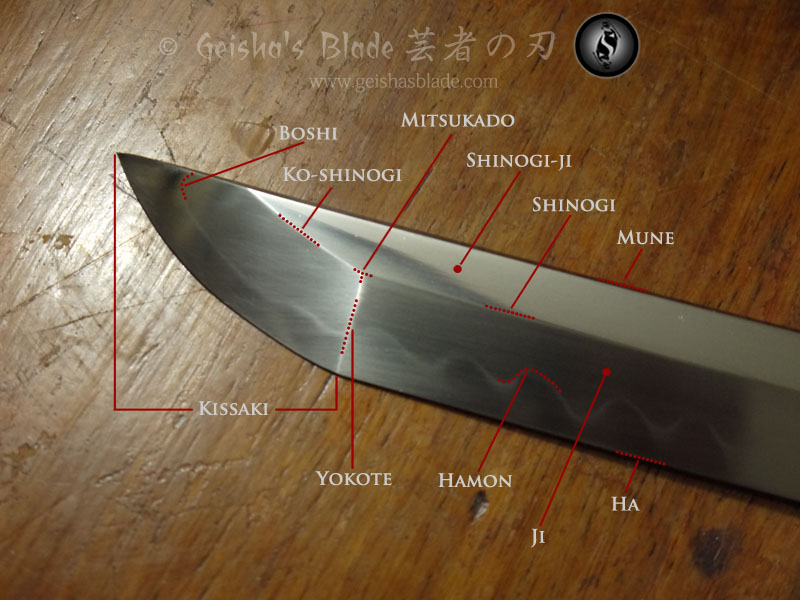
Now I can proceed with the review. Let’s start with the tsuka (handle) of the all-black sword. If you’ll notice, the tsuka is very “fat” and wide, almost straight. The tsukaito (handle wrapping) they used is a thin piece of fabric. Instead of samegawa (ray skin) under the tsukaito, they used some kind of leather. Probably pig skin from the looks of it. Also, I didn’t see any mekugi (pegs) on the handle so this indicates that the tang is most probably a “rat-tail tang“, which is just a thin piece of metal rod that is welded on the blade and then screwed inside the handle to lock the blade, or a half tang and then glued inside. In my opinion, it’s a rat-tail tang because the handle is very light. According to the person tending the stall, the handle is made of kamagong, though it wasn’t that heavy when I held it. I’m not sure if the whole handle is made of kamagong because most of it is covered, or if what he says is actually true. At the end of the handle is a hole to accommodate the knots acting like a kashira (butt cap/pommel).
Here’s a close up and much better photo of the materials used for the handle. You can see the quality of the fabric they used for the tsukaito—very thin, and it isn’t wrapped very tight. I’ve seen a lot of cosplay prop makers do a better job than this.
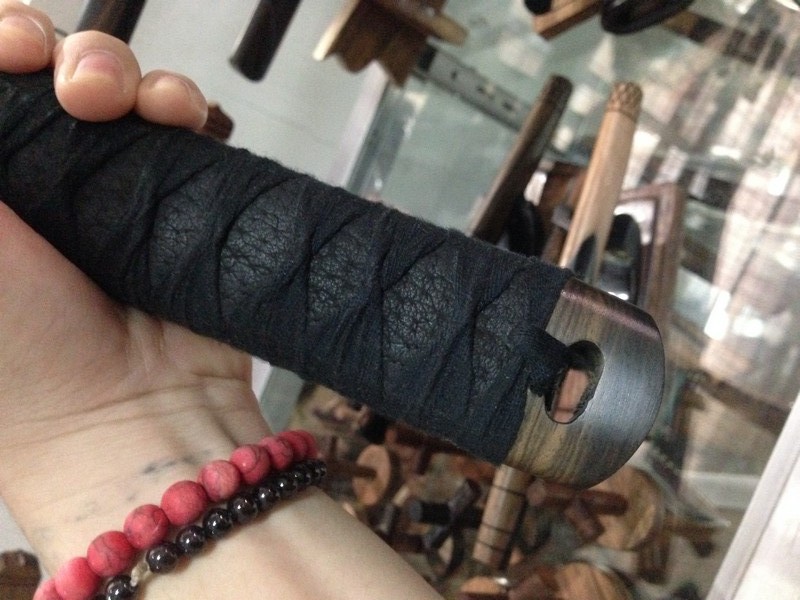
There’s a good reason why the Japanese used samegawa (ray skin or shark skin) for the tsuka. It’s not just for aesthetic purposes, but also serves a functional one. The nodes on the samegawa have little, tiny hooks. This helps in keeping the tsukaito in place so it won’t come loose easily and gives more grip.
I then inspected the sword fittings. It doesn’t have any seppa (spacers), menuki (handle ornaments), and kashira as mentioned earlier. It only has a habaki, tsuba, and fuchi. I asked the guy at the stall what the fittings were made out of. (From here on, let’s call the guy at the stall, “Guy”, as I will be mentioning him several times in this review.) When I asked Guy what the material of the tsuba (sword guard) is, he said he wasn’t sure, but he thinks it might be made of aluminum. It looks like stainless steel but not heavy, so he’s probably right. The design of the tsuba is supposed to be a Musashi style tsuba, but it isn’t a very good copy and it’s a bit crudely made. You can see some jagged edges inside the holes.
Here is a very fine replica of the “double ring tsuba” that is named after Miyamoto Musashi because it’s one of the tsuba he made. You can see the big difference between the two.
The habaki (blade collar) and the fuchi (handle collar) are made of stainless steel. The design on both is plain and simple. It’s so plain and simple that the mune-machi (back of the habaki) and ha-machi (where the cutting edge is) are a bit rounded.
Here you can see the tsuka that looks disproportionate to the blade due to its thickness and width.
I asked Guy if that dark part on the blade is rust, to which he said yes. This looks more like a burnt mark on the steel to me.
After inspecting the fittings, I moved on to the blade. Guy told me that it’s made of “muelye” (also known as leaf spring that comes from old vehicles). Most leaf springs are made of 5160 which is a carbon-chromium spring steel. It’s actually a very good steel for swords when tempered properly. However, not all spring steel are made of the same steel. It could be 1060, or 5160, or 9260, etc. You won’t know what type of steel it is unless you have it analyzed in a lab. Knowing the type of steel is very important to properly heat treat it if it’s supposed to be a functional sword to be used for training or cutting.ÂIf a blade is not properly heat treated, then it’s as good as a wallhanger.
Inspecting the blade further, I inwardly disapproved of what I saw. Not that I didn’t already frown when I inspected the tsuka and fittings, but the blade almost made me lose my calm. The first thing I noticed was the wide, shallow bohi (groove) on the blade. It’s so wide that it’s already at the edge of the back of the blade that I could not see any part of the shinogi-ji (flat of the blade) above the bohi anymore. I wasn’t able to swing it, but with the shallow bohi, I don’t think it will produce a very audible tachi-kaze (sword wind sound) or if it can even produce one.
The next thing I noticed was how the blade was sharpened. It has a secondary bevel. A katana blade is not supposed to have a secondary bevel on the edge because the “shinogi” (ridgeline of the blade) to the “ha” (sharp edge) is the whole cutting edge. Putting a secondary bevel ruins the geometry of the blade. It can still cut, but it’s not very traditional-looking and looks like a giant kitchen knife. There is very little curvature to the blade which starts at about 12 inches from the tip. Beyond that length up to the end of the handle is almost straight.
These series of photos show the very wide, shallow bohi and the secondary bevel on the edge
Aside from the wide, very shallow bohi and secondary bevel on the edge, did you notice anything else?
The polish of the blade leaves a lot to be desired. There are grind marks all throughout the blade. Even though it’s heavily covered in oil, you can still see them. Both swords I inspected have grind marks, as well as on a couple of Filipino swords they have on display (complete with the secondary bevel on the edge). Unfortunately, I wasn’t able to take photos of the blades of the Filipino swords.
What do those grind marks mean? It means that they used a grinder to polish and sharpen the blade. Using a grinder to polish and sharpen is not a very good method as it may heat up the blade and ruin the heat treatment. So that’s probably where the burnt mark came from as seen in one of the photos above.
I didn’t see any real hamon on this blade. It’s possible that it was obscured by the grind marks or there may be none at all. Not even a fake one.
5160 is almost the same as 1060 having 0.60% carbon content, so it’s very flexible that it can flex up to 45 degrees and still go back straight. Guy demonstrated the flexing capability of one of their swords. You can watch the video below.
Are you impressed? Probably people who don’t have much knowledge about Japanese swords and other sword manufacturers would be, but I wasn’t. I’ve seen other blades flex more and still go back straight. I wanted to grab the sword and flex it the way I do with my 1060 blade, but I was afraid that it might not go back to its original form. Even my personal 1050 blades can flex the same way theirs did. (Note that 1050 steel is not as flexible as a through-hardened steel which has 0.60% carbon content that allows it to bend up to 45 degrees without taking a set.) As you can see in the video below, the 1050 swords (Amatsukami Katana 1050 Iaito Series and Shirasaya Katana 1050 Series) flexed the same way the locally made sword did even with only 0.50% carbon content.
In the video above, the Amatsukami Katana was able to flex more because of its thinner blade, while I had a hard time flexing the Shirasaya Katana because of its comparatively thicker blade. If you noticed in Guy’s video, he didn’t seem to have exerted much effort in flexing the blade considering his position and the way he was holding the sword. This means that the blade is also thin. Now, the reason the Amatsukami Katana has a thin blade profile is because it was designed after Japanese-made iaito, serving as a fast and light katana for iaido/iaijutsu training. As for Guy’s sword… well, I don’t know why it’s thin.
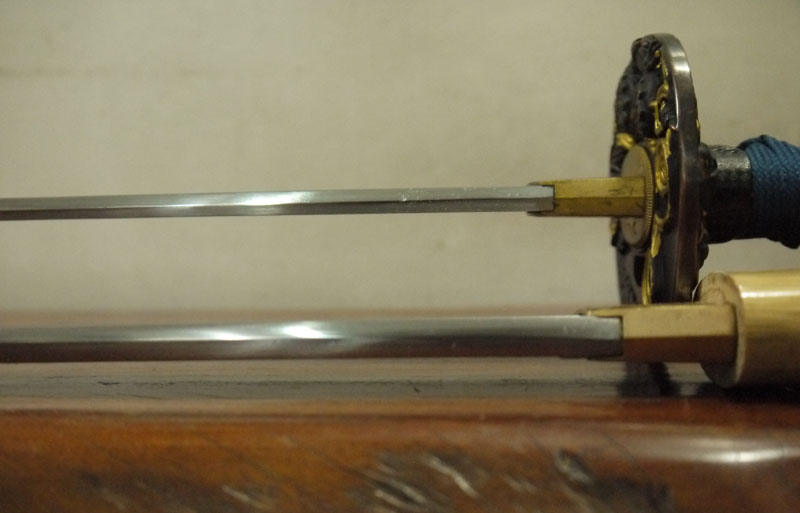
And here are a couple of flex test videos of my 1060 carbon steel blades.
I asked Guy if the sword can be used for cutting. He confidently said yes because it’s been “forged”. I wanted to shake my head to show disagreement when he said that because with the way this sword was constructed, it is not safe to use for cutting. Seeking confirmation to my earlier assumption that the sword does not have a full tang, I also asked if the handle can be removed, to which he said no. I was right. It’s either screwed in tightly (rat-tail tang) or glued. Using a sword with a rat-tail tang or one whose blade is not safely secured inside the handle for something other than putting it on display is unsafe. The reason being that the blade could fly out of the handle anytime causing injury to yourself or to others nearby. Obviously, Guy doesn’t know what he’s talking about. Or that’s what the owner/owners, main man/men of the store/company in Pangasinan told him who then also don’t know what they’re talking about, or it’s just a marketing ploy to make a sale and not keeping safety in mind.
The price of this sword is PHP 5,000. I asked Guy if they also have a sword whose blade can be removed from its handle. He said yes, but it’s not available in their stall in Baguio as, according to him, they immediately got sold out. They do have it available in their main store at Pangasinan, or you can pre-order it for the price of PHP 9,000. I asked if the blade is exactly the same as the PHP 5,000 sword, and he said yes, except that it has a “full tang” and that the blade can be removed. If that were the case, then it means that there would also be grind marks all throughout the blade, a secondary bevel on the edge, and a very wide and shallow bohi.
After inspecting the handle, fittings, and the blade, I moved on to the saya (scabbard). Guy said that the wood used is the same the Japanese use. The Japanese traditionally used honoki wood (in making tsuka, saya, shirasaya, and tsunagi) which is a species of Magnolia (Magnolia Hypoleucaea/Magnolia Obovata). Indigenous to Japan, honoki is a non-resinous wood which has served its place in Japanese sword furniture for centuries. But I doubt that they used/use honoki, because even custom Japanese sword makers in the US have a hard time obtaining it, so they use poplar as an alternative.
I asked exactly what kind of wood but I can’t remember if he said “sapang” (redwood) or “sagat” (yellow hardwood). They are suitable wood to be used for a saya but definitely not what the Japanese use. So is that another marketing ploy there? The type of wood used is not a big deal for me as long as it does the job in storing the blade and protecting it from moisture. Though I would prefer the type of wood that’s not heavy when performing “sayabiki” (pulling of the saya when drawing the blade out) during training. Guy said that the saya is painted with acrylic and it’s much better than the “shiny paint”, he said. The Japanese use “urushi”, which is a traditional lacquer for the saya, but highly toxic to the artisan. In modern production swords made in other countries, regular lacquer is used instead.
Moving on to the saya’s aesthetic, it has a matte finish that I think aims to looks like stained wood as you can see the wood grains and feel the texture. This would have been nice if the wood itself had a nice grain and the surface polished very smooth. As is though, it looks like an amateur paint job.
The “koiguchi” (mouth of the saya) is enforced with carabao horn. This helps in preventing the saya from splitting. The opening, however, is very, very wide. So wide, in fact, that the fit of the habaki is very loose and the sword easily slides out of the saya. This is very dangerous when you have the sword on display and someone accidentally bumps/hits it. The sword could fall out and that someone may try to catch it, ending up in cutting him/herself. This koiguchi can still be fixed, but you’ll have to use very thick wooden shims.
Then I inspected the 2nd sword they had on display. This one has an all wood design, and as per Guy, the handle is made of kamagong. I showed this photo to my friend at Makiling Weapons who specializes in wooden weapons and according to him, “It may be real, but not class A kamagong. If I’m not mistaken, the larger the part that is black, the better class of kamagong”.
When I posted this photo on our Facebook page, there were different opinions regarding the design. Some considered it beautiful, cool, and sexy, while others simply do not like it. I personally don’t. The handle looks nice for a piece of furniture, like the leg of a table or chair, or maybe part of a bed (headboard or legs). But for a katana handle, it’s just not working for me. It’s very untraditional. It would’ve been better if they had just made it plain, like a shirasaya. One comment described it as a “chairleg katana”. I think that accurately describes it because the saya also has a similar design as the handle.
Can you see the similarity of this handle and the chair/table legs below? Come to think of it, they can make a lot of different designs for this handle :p
I wasn’t able to take more photos of the saya of this particular sword, but it’s just plain wood with a similar design as the tsuka. According to Guy, the other half is made of kamagong, while the other half is made out of a different wood. I wasn’t able to ask anymore why it’s not made of one type of wood. Maybe they’re cutting costs and can only afford to use 1/2 kamagong since it’s a bit expensive? Just a guess here.
On the topic of kamagong: It’s an endangered tree species and protected by Philippine law. You’ll see a lot of arnis sticks being sold as kamagong but are really fakes or of very low quality that’s just been darkened. Kamagong is known for its hardness but it is due to this very hardness that also makes it brittle. Contrary to popular belief, hardness does not necessarily equal resilience. It’s called ironwood because it’s hard but easily breaks/shatters. This is the reason why a lot of Filipino Martial Artists who practice arnis prefer to use “bahi” over kamagong when doing contact training. They only use kamagong for exhibitions when they don’t need to hit their sticks on anything or for weight training since it’s a bit heavy.

After doing a bit of research about kamagong, this is what I found:
“When this wood begins growing it is simply brown. As it grows older it begins to develop a distinct black grain. The older it gets, the more black appears in the wood. Most Macassar Ebony wood in the market comes from young trees that produce a brown color. Often, Philippine tribes will stain this wood black using a local plant root to give it an authentic ebony look and increase its sale value. However, authentic Macassar Ebony wood is black all the way through the piece of lumber, not just on the surface. This wood is hard and very brittle and is notoriously difficult to work. Fine spiderweb-like cracks in the finished product are common and may be regarded as a sign of authenticity.”
My friend at Makiling Weapons also gave some tips on how to check if the wood is real kamagong:
1. Cut the wood using a saw. A small amount of white substance (kind of sticky) should come out from the wood.
2. Check the sound of the wood. Flick it with your finger and the sound should almost be the same as the sound of steel.
3. Try to scrape the wood with your fingernail. There should be no black paint in your nail.
This katana doesn’t have a lot of fittings, just the stainless steel habaki and brass tsuba. The habaki on this sword is the same as the other sword, a bit rounded on the corners. The design of the tsuba is supposed to be a tachi (predecessor of the katana) style tsuba. I can’t say that it’s a poor copy because I’m not really a fan of this style of tsuba.
There is one thing I can say: it has the same shape as the tsuba on the cheap display katana made in China I bought many years ago.
The blade is the same as the other sword; grind marks all throughout the blade, secondary bevel on the edge, very wide, shallow bohi. It is also priced at PHP 5,000.
You can clearly see the grind marks in the photo above. Actually, you can see the grind marks in most of the photos I took of the blades and it’s similar to the blade of the cheap sword I bought in Baguio years ago.
I forgot to mention that for the price of PHP 5,000, you get a free sword stand. I wasn’t able to take a clear photo of the free stand, but it’s the one behind this guy. This is Guy, by the way. He says he is related to the owner. I covered his face to protect his identity as he’s just doing his job the way he’s been instructed.
As for the feel and balance of these 2 swords, they’re pretty off. They’re a bit heavy at the tip. This is because of the overall blade profile and they don’t have a full tang to counter the weight. A “tip heavy” sword is a quite hard to use because it puts too much strain on your wrist, giving you a tough time controlling it. Remember, you control the sword; not the other way around.
Before I left the stall, I just had to ask Guy one last question. I asked if they were the ones who made the swords used in the movie LOTR. He said yes, and he also said that they also made the sword for the movie Braveheart. Although they don’t have it available there at their stall, you can get it at their main store. I wanted to mention Weta Workshop in New Zealand and Simon Atherton from the UK, but he probably doesn’t know about them so I just “smiled”, thanked him for his time, and walked away.
So what do you think of this “100% Philippine Made Samurai Katana Sword” from Pozorrubio, Pangasinan? I am not writing this review to bash anyone; I am just pointing out the things I saw when I inspected their swords. Everything here is based on my personal views as a consumer, sword collector, and Japanese martial arts practitioner—not as the owner of Geisha’s Blade.
Please note that not all sword makers in the Philippines make swords like this. In fact, there are several sword makers that make excellent swords. One example is Kris Kutlery which is based in the US. This company is owned by Cecil B. Quirino. All of Kris Kutlery’s swords are made in the Philippines. I’m not exactly sure where, but definitely not made by the company that made the swords in this review. They sell Philippine swords, Medieval, Japanese, and Chinese. The blades of their Japanese swords are quite good and a lot of people in the US like them. It’s also made of 5160 steel and with a little work, you can bring out the natural hamon. I don’t know why, but in 2012(?), Kris Kutlery stopped offering Japanese style swords made of 5160 from the Philippines and started offering Japanese style blades made of 1060 and 9260 from China. Their Philippine swords are still made of 5160, though. Maybe it’s because the swords in China are much better and cheaper? They have on their FAQ page information about the steel they use for their swords and where it’s made.
Another company that’s also based in the US is Traditional Filipino Weapons, owned by Ron Kosakowski. TFW also sells a wide variety of swords: Philippine blades, Medieval, Japanese, and Chinese all made in the Philippines, but the quality far exceeds the 2 swords mentioned in this review. I also don’t know where they are located, but most probably in the northern part of the Philippines. Here’s a sample of a Japanese style sword made by TFW.
Katana by Traditional Filipino Weapons
You can see they both look very nice and you wouldn’t think they’re made in the Philippines if you compare it to the swords in this review. Although they also don’t have a samegawa on the tsuka, they still looks nice. The blacksmiths who make the swords for Kris Kutlery and Traditional Filipino Weapons keep a low profile, humbly making and selling their swords internationally. You can also buy their swords locally if you know where to find them.
I wanted to buy one sword from the stall so I could fully inspect it when I got home; try to remove the handle, flex the blade some more, etc. But Jaimee didn’t want me to waste my money on a katana-like object. If you’re interested in these swords or you want to see the quality for yourself, you can go to their stall at the new multipurpose building at Mines View Park. There’s an entrance on the left side and you’ll see their stall on the ground floor.
I hope this review has helped you gain more knowledge about the swords made here in the Philippines, and I hope that Geisha’s Blade will be working with some of the local blacksmiths here in the Philippine to produce better blades soon!

